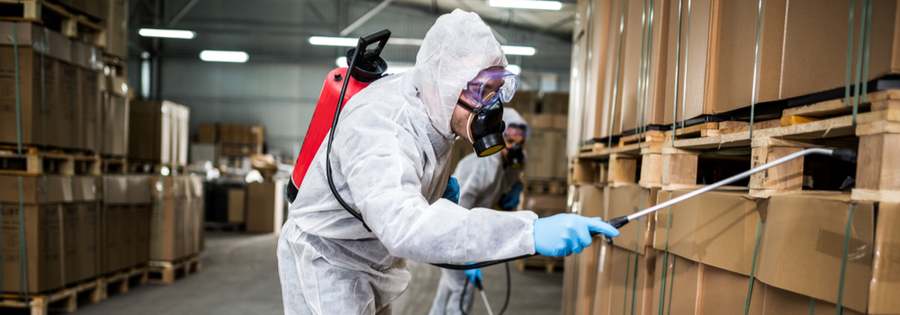A Comprehensive Overview to the Different Sorts Of Parasite Control Approaches
With the myriad of bug control approaches offered, it can be frustrating to discover the most reliable service for a specific parasite trouble. In this extensive guide, we will certainly explore these different types of pest control approaches, supplying understandings into their applications and advantages. By the end, you will have a clearer understanding of which method may be the ideal fit for your pest control needs.
Chemical Pest Control Approaches

One usual type of chemical insect control is pesticides. Insecticides target certain pests, such as insects, termites, or ants, and can be used both inside and outdoors.
One more sort of chemical parasite control is rodenticides. These are chemical materials created to regulate populations of rats, such as rats and mice. Rodenticides are typically made use of in lure form, which attracts the rats and afterwards eliminates them after consumption. They are generally made use of in farming settings, along with in household and commercial buildings (Customized pest control solutions Chicago).
Herbicide, likewise called herbicides, are an additional kind of chemical bug control approach. Herbicides are designed to uniquely kill unwanted plants, known as weeds, without triggering harm to preferable plants. They are typically utilized in farming, landscaping, and horticulture to control the development of undesirable vegetation.
While chemical bug control methods can be extremely efficient in removing bugs, it is necessary to use them deliberately and adhere to security standards. Overuse or abuse of chemical pesticides can have negative effect on human health and wellness and the environment. It is essential to use these methods responsibly and consider alternate pest control methods whenever feasible.
Organic Bug Control Approaches
Biological bug control techniques entail the usage of living microorganisms or natural substances to take care of and manage pest populaces. Unlike chemical techniques, which often depend on artificial pesticides, organic control methods make use of the all-natural enemies of bugs to manage their populaces. This strategy is considered even more eco-friendly and lasting, as it reduces using hazardous chemicals and reduces the threat of pesticide resistance.
One widely used organic parasite control technique is the introduction of all-natural killers or bloodsuckers. For instance, ladybugs are presented to manage aphids, while specific wasp species are launched to target caterpillars. These killers and bloodsuckers prey on bugs, reducing their numbers and avoiding invasions.
One more organic control technique is using microorganisms. Particular bacteria, infections, and fungi can be employed to contaminate and kill specific pests. The microorganism Bacillus thuringiensis is generally used to control caterpillars, as it generates contaminants that are lethal to these bugs.
Organic control methods can likewise include using scents or natural materials that interrupt the mating patterns of insects. By hindering their reproduction, these approaches assist to reduce pest populations with time.
While organic parasite control techniques are usually reliable, they may call for longer durations to achieve preferred outcomes compared to chemical approaches. Additionally, careful factor to consider must be offered to the option and release of all-natural enemies to avoid unintended injury to beneficial organisms or environments.
Physical Insect Control Techniques
To properly take care of and manage pest populations, different parasite control approaches more called physical insect control techniques are employed. These methods entail the use of physical barriers, traps, or devices to avoid bugs from accessing or harming building. One common physical insect control technique is using displays or internet to maintain bugs out of structures or yards. These screens are generally made from fine mesh material that allows for air flow while preventing bugs from getting in. One more physical parasite control technique is the installment of fencings or wall surfaces to keep bigger pests, such as deer or rabbits, out of yards or farming areas. These obstacles physically obstruct the parasites' accessibility to the location, lowering the capacity for damages. Furthermore, catches and devices can be utilized to capture or push back insects. As an example, sticky traps can be positioned in locations where pests are a problem, and the bugs end up being adhered to the sticky surface area. Ultrasonic gadgets can also be used to produce high-frequency audios that are unpleasant to pests, causing them to leave the area. Physical pest control approaches are an eco friendly alternative to chemical pesticides, as they do not count on making use of dangerous chemicals.
All-natural Bug Control Techniques
Natural parasite control techniques offer a lasting and environmentally friendly strategy to managing and eliminating pests. One of the most common natural pest control techniques is biological control. By embracing these natural insect control techniques, individuals and communities can properly take care of bugs while reducing the adverse click to read more effects on the setting and human health.
Integrated Parasite Administration (IPM)
Integrated Parasite Monitoring (IPM) is a comprehensive and methodical strategy to pest control that integrates different techniques and techniques to effectively manage insects while reducing the use of chemical pesticides. IPM aims to keep insect populaces listed below the financial injury level by using a mix of cultural, organic, and chemical control techniques.
Social control methods entail changing the setting to make it much less favorable for bugs. This can consist of techniques such as plant turning, correct hygiene, and the usage of resistant plant ranges. By creating unfavorable problems for bugs, cultural control approaches can significantly lower insect populaces.

Chemical control techniques are utilized as a last hope in IPM. They include the targeted and sensible usage of chemicals to handle insect populaces. Unlike traditional insect control techniques, IPM aims to minimize making use of chemical pesticides by utilizing alternative techniques.
Integrated Insect Monitoring (IPM) is a positive strategy that concentrates on long-term parasite monitoring as opposed to depending exclusively on reactive steps. you can look here By incorporating multiple control approaches, IPM provides a much more sustainable and eco-friendly approach to pest control.
Final Thought
It discussed chemical, organic, physical, and all-natural parasite control methods, as well as the integrated pest management strategy. By comprehending these numerous techniques, people can make educated choices on which pest control method is most appropriate for their particular needs and preferences.